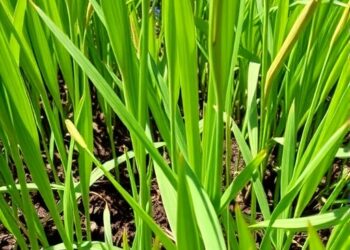A Dartmouth study conducted on fruit flies reports the first evidence in any organism that oocytes—the cells that become eggs—regularly rejuvenate the critical protein linkages that bind chromosomes together. The findings are a potentially important step toward helping women reduce their risk of pregnancy complications as they age, the researchers report in the journal Current Biology.
A Dartmouth study conducted on fruit flies reports the first evidence in any organism that oocytes—the cells that become eggs—regularly rejuvenate the critical protein linkages that bind chromosomes together. The findings are a potentially important step toward helping women reduce their risk of pregnancy complications as they age, the researchers report in the journal Current Biology.
Women are born with the oocytes they will have for life, and the cohesive linkages that connect chromosomes are established in those cells prenatally. When they reach childbearing age, ovulation triggers the oocyte to divide, resulting in the formation of an egg that can be fertilized by a sperm. Cohesive linkages must be present in the dividing oocyte to form an egg that contains the correct number of chromosomes.
As a woman ages, so do her oocytes. The loss of cohesive linkages as oocytes age is one factor that increases the likelihood of miscarriages and conditions such as Down syndrome for older women, a phenomenon known as the maternal age effect. The risk of cell division producing an egg with the wrong number of chromosomes goes up significantly after the age of 30.
But the Dartmouth researchers discovered that in fruit fly oocytes, new cohesive linkages form on the chromosomes to replace the originals. They monitored specific proteins within the cohesin complex—the group of proteins that mediate the linkages between chromosomes—and found that this rejuvenation process occurs throughout the development of the fly oocyte.
“Our work is the first in the field to demonstrate that cohesive linkages in oocytes can form after the original linkages are generated,” says Sharon Bickel, professor of biological sciences at Dartmouth and the paper’s corresponding author.
“Whether organisms other than fruit flies utilize cohesion rejuvenation in oocytes is not known,” Bickel says. “But it is hard to understand why rejuvenation would be necessary to keep cohesion intact for six days in fruit fly oocytes, but not in human oocytes that undergo decades of aging.”
The researchers propose in their paper that if human oocytes do have the ability to rejuvenate cohesive linkages, this mechanism may become less efficient because of oxidative damage brought on by aging. A decline in rejuvenation could lead to an overall loss in chromosome linkages, Bickel says.
The Bickel Lab uses fruit flies as a model for investigating the molecular mechanisms underlying chromosome cohesion. They have found that the effects of aging on fruit fly oocytes are similar to that seen in humans. In 2008, the lab reported a method for “aging” fruit fly oocytes that provided evidence that aging causes a loss of cohesive linkages. A 2016 paper showed that increasing oxidative damage in fruit fly oocytes also results in the loss of cohesive linkages, while a 2019 paper from the lab reported that decreasing oxidative damage in aging oocytes improves cell division outcomes.
“If we can identify the proteins and the mechanisms that underlie cohesion rejuvenation in this system, that could inform the development of therapeutic strategies designed to enhance rejuvenation in the eggs of older women and slow the loss of cohesion,” Bickel says.
Muhammad Haseeb, a postdoctoral researcher in Bickel’s lab and the paper’s first author, says that evidence for turnover in cohesive linkages has proven elusive for researchers. To date, experiments performed in mice have reported no signs of rejuvenation.
The Dartmouth researchers took several different approaches, says Haseeb, who began the project as a graduate student in Dartmouth’s Molecular and Cellular Biology program. Some of the fly strains the team utilized were generated by co-author Katherine Weng when she was a graduate student in Bickel’s lab.
The tools available for fruit fly experiments allowed the researchers to manipulate proteins at an earlier stage in oocytes, but still after the original cohesive linkages had formed. They also used two different methods to monitor a protein that exists in all varieties of the cohesin complex found in fruit fly oocytes, Haseeb says. Researchers working in mice focused on a single protein present in only a subset of cohesin complexes in mouse oocytes, he says.
“It is possible that one or both of these differences account for our findings,” Haseeb says. The paper may help facilitate further experiments in mouse oocytes that could help forge a clearer path to discovering and understanding this process in humans, he says.
“Interestingly, two of the regulatory proteins that we know are required for rejuvenation in fly oocytes also are present on mouse oocyte chromosomes—after the original cohesive linkages are formed,” Haseeb says. “That is consistent with them playing a role in rejuvenation in mammals.”
Bickel and Haseeb take the study one step further in a paper published June 8 in the journal G3 with co-authors Alana Bernys ’20 and Erin Dikert ’21, who worked on the project as Dartmouth undergraduate students. In it, the researchers identify proteins required for rejuvenation so that the molecular pathway or pathways can be better understood.
An additional project ongoing in the Bickel Lab is testing whether nutritional supplements can reduce the risk of chromosome errors in fly oocytes that have undergone aging.
The paper, “Chromatin-associated cohesin turns over extensively and forms new cohesive linkages in Drosophila oocytes during meiotic prophase,” was published June 12, 2024, by Current Biology. This work was supported by the National Institutes of Health (grant no. R01GM05934).
###
Journal
Current Biology
Method of Research
Experimental study
Subject of Research
Cells
Article Title
Chromatin-associated cohesin turns over extensively and forms new cohesive linkages in Drosophila oocytes during meiotic prophase
Article Publication Date
12-Jun-2024




